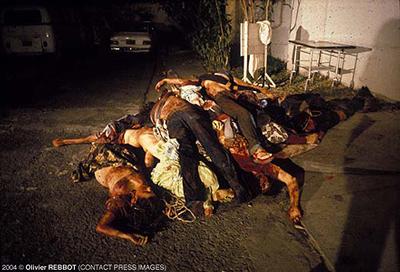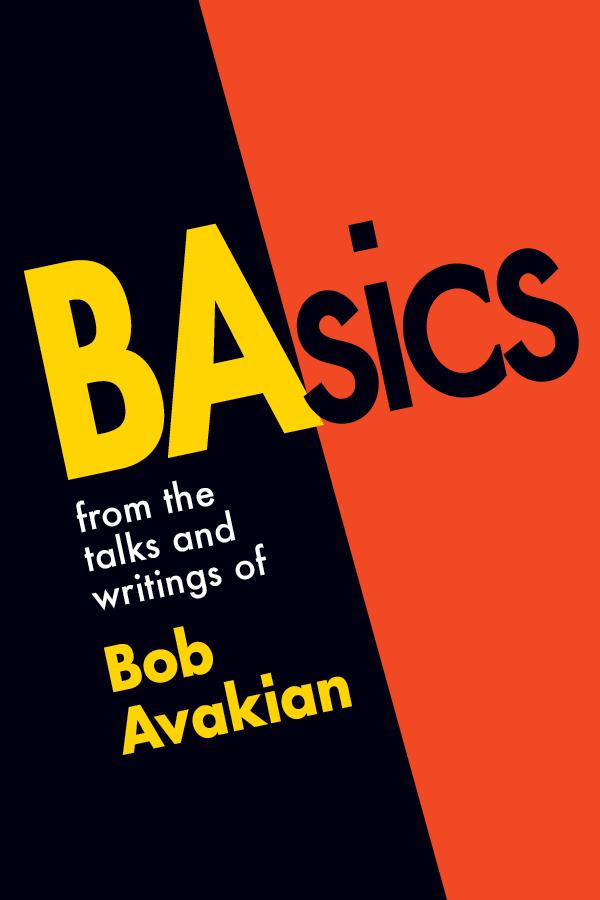Bob Avakian has written that one of three things that has “to happen in order for there to be real and lasting change for the better: People have to fully confront the actual history of this country and its role in the world up to today, and the terrible consequences of this.” (See “3 Things that have to happen in order for there to be real and lasting change for the better.”)
In that light, and in that spirit, “American Crime” is a regular feature of revcom.us. Each installment focuses on one of the 100 worst crimes committed by the U.S. rulers—out of countless bloody crimes they have carried out against people around the world, from the founding of the U.S. to the present day.
See all the articles in this series.


Massacre in the village of El Mozote, El Salvador, December 11, 1981.
Operación Rescate (“Operation Rescue”) was part of the “anti-guerrilla campaign,” but there were no combatants in El Mozote. The villagers (some shown here), completely unarmed, were massacred during the Reagan administration.
THE CRIME
Throughout the decade of the 1980s into the early 1990s the U.S. government backed, trained, and financed the reactionary government and military of the Central American country of El Salvador in its murderous counterinsurgency war that killed tens of thousands of workers, peasants, students, intellectuals, artists and others and forced hundreds of thousands to flee into exile.
El Salvador was dominated by U.S. imperialism in league with a few Salvadoran families who controlled the vast majority of the country’s land and wealth, while millions of peasants, workers and others lived in extreme poverty. They had no democratic rights and during the 1960s and 1970s their political protests were violently suppressed. In 1977, the Salvadoran military killed hundreds peacefully protesting voter fraud. The Salvadoran government unleashed paramilitary vigilante groups or “death squads” against its opponents, kidnapping and murdering leaders of labor unions, peasant organizations, political parties, and guerrilla groups, as well as priests and lay religious workers who sided with the poor.
Starting in the 1950s, the CIA and U.S. military built up, trained, funded, organized, and helped guide the Salvadoran military, police, and death squads. U.S. advisers even provided them with target lists.
In October 1979 young military officers seized power in a coup against El Salvador’s president, General Carlos Romero. The coup leaders called for some reforms, but old-line officers supported by the U.S., co-opted the regime and intensified repression against the population. As a result, many more, including former liberals, joined the growing armed resistance. (In October 1980, a number of guerrilla groups joined to form the FMLN - Farabundo Martí National Liberation Front—which was backed by the Soviet Union and Cuba and became the main force fighting the U.S.-backed government.)
As 1980 began, civil war was brewing. In late January a government crop duster sprayed DDT on protesters marching in the capital. When the demonstrators reached a central plaza, military snipers started firing, killing 21 and seriously wounding 120. On March 17 a general strike was called and the government responded violently, killing 54 in the capital city of San Salvador alone.
A week later, the Archbishop of San Salvador, Oscar Romero, who had called upon U.S. President Carter—“Christian to Christian”—to end aid to El Salvador’s military, was gunned down inside his church. In his last sermon, he had addressed the security forces with these words: “I beseech you I beg you, I order you, in the name of God: stop the repression.” The Archbishop was the 11th priest murdered in El Salvador in three years. The architect of Romero’s murder was a U.S. trained intelligence officer and leader of El Salvador’s fascist Arena party, Roberto D’Aubuisson.
At the funeral of the martyred archbishop a bomb was thrown among the mourners followed by rifle and automatic fire leaving at least 40 people dead and hundreds injured.
During the early months of 1980, the Salvadoran government, under guidance from the U.S., enacted a so-called “agrarian reform” which was actually part of its counterinsurgency campaign. A member of the Instituto Salvadoreño de Transformación Agraria who witnessed the “implementation” of the reform later testified: “The troops came and told workers the land was theirs now. They could elect their own leaders and run it themselves. The peasants couldn’t believe their ears, but they held elections that very night. The next morning the troops came back and I watched as they shot every one of the elected leaders.”
On December 2, 1980, four Catholic missionaries from the United States working in El Salvador were raped and murdered by five members of the El Salvador National Guard.
In December, 1981, a unit of the Salvadoran military carried out a horrendous massacre in the village of El Mozote intended to terrorize the population. After entering the village men, women, children, and the elderly were separated in groups around the town plaza. The men and women were tortured and shot. Young women were taken up a hill, raped, and murdered. One hundred forty-six children from ages three days to 14 years, were brutally killed.
Soldiers smashed the skulls of small babies and decapitated older children. Pregnant mothers were shot, then had large rocks dropped on their stomachs to kill the fetus. Soldiers then set fire to the church where the children had been killed. Guerrillas who entered the smoldering town the next day recalled seeing animals pick at decapitated heads, strewn about, as smoke rose from charred bodies. About 1,000 people, almost the entire town’s population, were tortured and slaughtered in El Mozote. The military unit that carried out the massacre, the Atlacatl Battalion, was specially trained by the U.S. military at the infamous School of the Americas at Ft. Benning, Georgia.
The response of the U.S. to these events was a massive increase of military aid to El Salvador’s military and police. From 1980 to the early 1990s, U.S. provided an estimated $6 billion in military aid to the Salvadoran regime. Its military grew from an estimated 7000 to 12,000 men in 1979, and jumped to more than 22,000 by 1983, with an additional 11,000 civilian security forces. Three years later the total forces spiraled to 53,000. The equipment made available to them included advanced and deadly military aircraft.
The U.S. bore the cost of training Salvadoran military personnel in the U.S. and the Panama Canal Zone as well as in El Salvador. Further training was provided in the earlier years of the war by Argentina, Chile, and Uruguay at U.S. behest. Substantial military aide was routed through Israel. Considerable evidence surfaced of a U.S. role in the ground fighting as well, including a CBS news report of U.S. advisers “fighting side by side” with Salvadoran government troops.
In 1984, Amnesty International received regular reports identifying Salvadoran regular security and military units responsible for the torture, disappearance and killing of non-combatant civilians from all sectors of Salvadoran society. One Salvadoran Army deserter told the New York Times in 1982 that he attended a class in which severe methods of torture were demonstrated on teenage prisoners. He stated that eight U.S. military advisers were present at the time.
Death squad executions, military massacres and modern U.S. weapons employed against guerrillas and those suspected of supporting them, led to as many as 75,000 deaths. Fearing for their lives and those of their families, hundreds of thousands of Salvadorans fled north seeking refuge. Between 1980 and 1990, the Salvadoran immigrant population in the United States increased from 94,000 to 465,000. When the U.S. refused to grant asylum to many of these refugees, immigrant rights groups and churches aided the refugees coming into the U.S. and a Sanctuary church movement took hold in the U.S. In 1985 San Francisco, California became the first city to declare itself a City of Refuge.1


In El Salvador a right-wing government backed by the U.S. suppressed a leftist rebellion in a 12-year war beginning in 1980—killing and torturing more than 70,000 people in a country with a population of about six million. Above: "Death squad" victims in San Salvador, El Salvador, 1981.
THE CRIMINALS
Jimmy Carter: Days before his term ended in January, 1981, Carter ordered a total of $10 million in military aid along with additional American advisers to be sent to El Salvador, an action characterized by one observer as “President Carter’s foreign policy establishment’s last convulsive effort to evade responsibility for having been ‘too soft’ in dealing with Salvadoran rebels.”
Ronald Reagan: When Ronald Reagan became president in early 1981 he immediately expanded direct U.S. involvement in the war in El Salvador. Under Reagan the U.S. sharply escalated U.S. military spending, began a public relations campaign to put a human face on the military junta and a campaign to convince the U.S. public and the world that the Salvadoran opposition had no legitimate cause for rebellion.
On January 28, 1982, two months after the massacre at El Mozote, Reagan certified to Congress that the El Salvadoran government was “making a concerted and significant effort to comply with internationally recognized human rights” and that it was “achieving substantial control over all elements of its own armed forces, so as to bring to an end the indiscriminate torture and murder of Salvadoran citizens by these forces.” These were deliberate and outrageous lies.
The U.S. CIA and military funded, armed, trained, and advised the Salvadoran military and its death squads.


BAsics from the talks and writings of Bob Avakian
The essence of what exists in the U.S. is not democracy but capitalism-imperialism and political structures to enforce that capitalism-imperialism. What the U.S. spreads around the world is not democracy, but imperialism and political structures to enforce that imperialism.
—Bob Avakian, BAsics 1:3
THE ALIBI
President Reagan said the U.S. was acting in El Salvador “to halt the infiltration into the Americas by terrorists and by outside interference and those who aren’t just aiming at El Salvador but…are aiming at the whole of Central and possibly later, South America and, I’m sure, eventually North America.”
THE REAL MOTIVE
The U.S. imperialists had long considered Central America part of their “back yard,” and for decades had installed despots and military juntas that enabled U.S. capital to plunder the region’s labor and resources. In the 1980s, however, the rivalry between the U.S. and the Soviet Union, by then an imperialist power, for global dominance was sharply escalating, and the central focus of U.S. strategy was confronting the Soviets and rolling back their influence. This included viciously crushing the anti-U.S. uprisings and guerrilla struggles rocking Nicaragua, El Salvador and Guatemala which the Soviets and their Cuban allies were supporting. Especially under Reagan the U.S. unleashed a bloodthirsty war against the Salvadoran people with the aim of thoroughly crushing any forces aligned with or sympathetic to the Soviet Union, as well as any resistance to the extremely oppressive, U.S.-backed order.
Sources:
Blum, William. Killing Hope. Common Courage Press, 2004
Roberto Lovato, “El Salvador’s Gang Violence: The Continuation of Civil War by Other Means,” The Nation June 8, 2015
Jon Santiago, “Revisiting American Involvement in El Salvador: The Massacre at El Mozote,” Huffington Post, May 25, 2011.
Raymond Bonner, “Time for a US Apology to El Salvador,” The Nation May 9—16, 2016.
Migration Policy Institute, “Salvadoran Immigrants in the United States,” January 5, 2010
1. Today in the U.S. there are 580 cities, counties, and states that have declared Sanctuary. [back]
